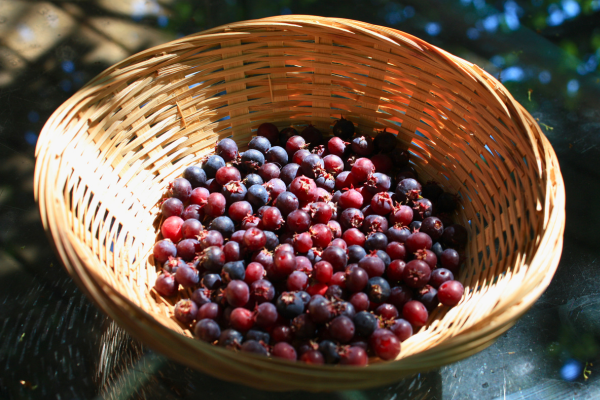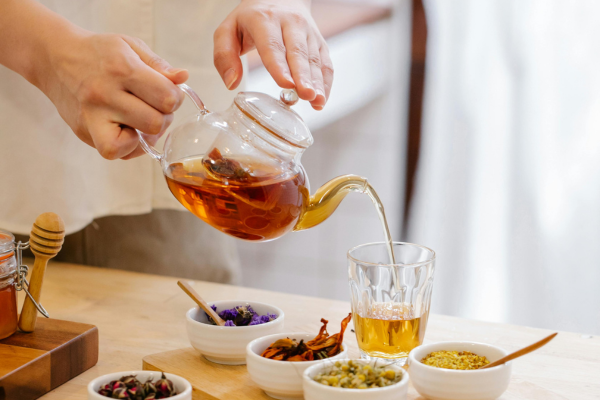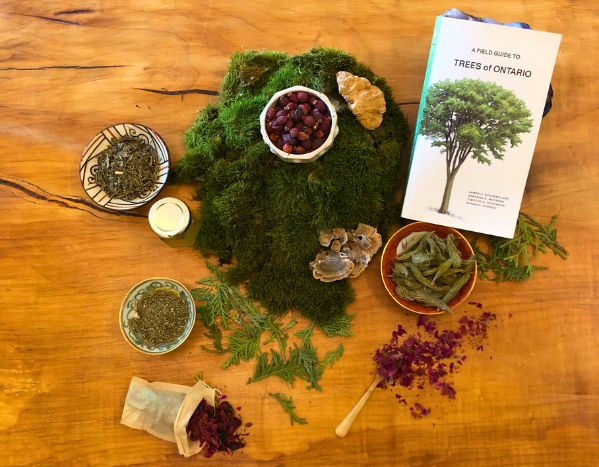Amba’s Guide to Tea Making
Many of us instinctively reach for imported herbs like lemongrass or rooibos, but the native trees and shrubs that grow right here in southern Ontario offer their own flavour, nourishment and seasonal variety.
Appreciation for local and seasonal ingredients has influenced my career, from leading a preserves and pickling department where I developed recipes using seasonal, foraged and sustainable ingredients to supporting homeowners in planting native gardens through my current role at LEAF.
With a background that bridges culinary and ecological work, I’ve found tea-making to be a natural extension of both. This guide shares one approach to creating simple, thoughtful blends using native trees and shrubs. From harvest to cup, it invites you to build your own pantry and your palate one cup at a time.
Harvest & store with care:
Whether you gather from the wild or your own garden, harvesting is best approached as a quiet exchange rather than a transaction, and it starts with observation. Ask yourself:
Is the plant healthy and abundant in the area? Are birds or insects relying on it as well? Am I leaving enough behind for the plant to thrive and regenerate?
Some common harvesting guidelines:
- Take only what you need (no more than ten percent from any given plant or area).
- Harvest at the right time to preserve plant health.
Stick to parts that regenerate easily, such as twigs, leaves, flowers or berries, and avoid harvesting bark from tree trunks, as this can potentially damage the tree long term.
A Note on Safety
Before making any tea, it’s essential to be sure of the plant you’ve gathered. Some native species have toxic lookalikes, and even safe plants can have varying effects on people.
Keep these safety basics in mind:
- Only harvest plants you can confidently identify: Use regional field guides, join local plant walks and cross-check with trusted sources. Learn both common and Latin names.
- Avoid harvesting from polluted areas: Roadsides, old industrial sites or any location with potential chemical runoff.
- Start slowly: Try one plant at a time and pay attention to how your body responds.
- When in doubt: Wait. The plants will still be there next season.
**If you're pregnant, breastfeeding, taking medication or living with a health condition, consult your health care provider to ensure a plant is safe before using it.**

Once you have identified your plant and safely harvested it, the next step is to dry and store it properly so that it is ready to brew. Most can be air-dried in a shaded, well-ventilated spot. Lay them in a single layer and turn them every day or so until they are fully dry. Store in jars or paper bags labelled with the plant name, part and date. Keep them out of direct light and use within a year for optimal flavour and potency.
To explore more about the ins and outs of foraging, please visit the resources page of Forbes Wild Foods.
With your plants dried and stored, it’s time to think about how they come together in a cup.
How tea blends work:
Good tea blends rely on balance. Like a recipe, each ingredient plays a specific role. Some provide structure, others carry the flavour and a few add brightness or depth. Learning to blend is about noticing how these layers interact and adjusting until the cup feels right.
Anatomy of a tea blend:
- Base (two parts): The foundation. These are smooth and steady elements that give tea structure, body and warmth. Often neutral or slightly sweet.
- Heart Notes (one part): The core flavour. Where richness, fruitiness, sweetness or tartness sit.
- Top note (half part): The lift. Bright, fleeting, aromatic or citrusy ingredients that hit the nose and palate first.
- Accent or medicinal elements (quarter part): Small additions that bring grounding, depth, function or subtle rounded balance to a blend. Because they tend to be strong or aromatic, they’re best added in small, deliberate amounts.
Blending tea is part structure, part intuition. Over time, you’ll sense when a cup needs more brightness, more softness or something to hold it together.
Build your pantry & palate:
Native trees and shrubs offer more than flavour; they follow the seasons. Spring brings tender evergreen tips, summer offers flowers and autumn delivers berries. As you gather and dry these gifts throughout the year, your tea shelf becomes a reflection of the seasons: a jar of petals, a handful of dried fruit and a bundle of winter needles.
Before blending, get to know your ingredients one at a time. Steep each plant separately and pay attention not just to the flavour, but also to how it feels. Is it sweet, tart, bitter or mellow? Does it linger or fade? Do you feel it in the mouth, throat or sinuses? Tasting this way builds your sensory vocabulary and reveals how flavours bring structure, softness or lift.

To brew:
• Steep one to two teaspoons of dried plant material per cup of hot (not boiling) water for five to ten minutes.
• Use a lid while steeping to retain aromatics.
• Strain and adjust to taste. Add sweetener, if desired.
• For iced tea: brew as above, let it cool, then refrigerate before serving over ice.
Use the chart below to explore the flavours, plant parts and harvest times of native species offered through LEAF. It’s a practical tool to help you build your own seasonal tea blends.

Recipes
Sunset Berry
Smooth and mellow with soft fruit and citrus lift.
- Base: Basswood flowers – smooth, honeyed body
- Heart Notes: Serviceberry (dried berries) – soft, raisin-like fruitiness
- Top Note: Fragrant sumac berries – tart, lemony brightness
- Accent: Pasture rose petals – gentle floral softness without overpowering
Forests Edge:
A slightly citrusy, grounded tea
- Base: Lowbush blueberry leaf –steady, earthy and slightly tannic
- Heart Notes: pasture rose hip– tart and fruity
- Top Note: White pine needles – bright, resinous and citrusy
- Accent: Spicebush twigs, leaves and berries – grounding, aromatic and peppery

Using native plants for tea blends offers both beauty and ecological value. Start small, observe what works and gradually build a collection of plants that nourish both your body and the environment.
Get Started with LEAF
Explore native plant options for your garden with LEAF’s Backyard Tree Planting Program. Visit our Homeowners page or check out our Shrubs, Cedars, and Pawpaws page to learn more and begin your planting and brewing journey.
Amba is the Residential Planting Assistant at LEAF, where she supports clients in building thriving native gardens at home. Whether fermenting berries or tending a young spicebush, she’s continually captivated by the edible gifts of Ontario’s landscapes and thrilled to keep learning (and tasting) more.
LEAF offers a subsidized Backyard Tree Planting Program for private property. The program is supported by the City of Toronto, the Regional Municipality of York, the City of Markham, the Town of Newmarket, the City of Vaughan, the Regional Municipality of Durham, the Town of Ajax, the Municipality of Clarington, the City of Oshawa, the City of Pickering, the Township of Scugog and the Town of Whitby.
